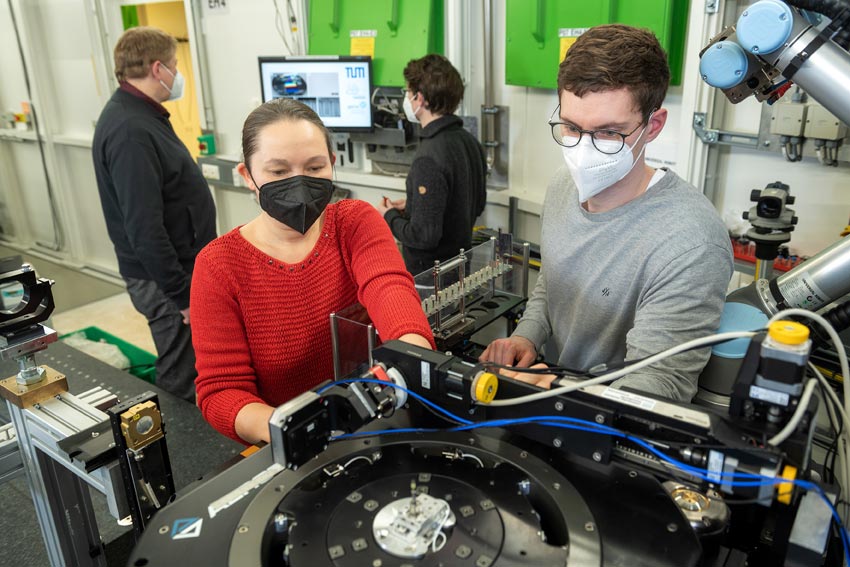

Prof. Dr. Julia Herzen mit Team am Mikro-Computertomograph
Photo: René Lahn / TUM
Researchers in biomedical physics and biology have significantly improved micro-computed tomography, more specifically imaging with phase contrast and high brilliance x-ray radiation. They have developed a new microstructured optical grating and combined it with new analytical algorithms. The new approach makes it possible to depict and analyze the microstructures of samples in greater detail, and to investigate a particularly broad spectrum of samples.
Micro-computed tomography (micro-CT) is an imaging method which generates detailed three-dimensional images of the internal structure of samples with small dimensions. Researchers in biology, medicine or material sciences can use this method to obtain information on the structure and characteristics of tissue and material samples which are important in diagnoses and other analyses.
Micro-CT is based on x-ray images which are reconstructed to form a three-dimensional image. Depending on the sample, different x-ray imaging methods are used in order to achieve the most accurate depiction possible. Here the key parameters are resolution, contrast and the sensitivity of the method used.
X-ray imaging with phase contrast
X-ray imaging with phase contrast is particularly well-suited for investigating soft tissue. The method employs the refraction of the x-rays caused by the sample’s structures in order to obtain contrast for these structures and thus to depict soft tissue in greater detail than it is possible with conventional x-ray methods.
In many phase-contrast methods, optical components modulate the x-rays on their way to the detector, resulting in what is referred to as a diffraction pattern at the detector. “When comparing this pattern with and without the sample in the x-ray beam, the refraction of the x-rays on the sample provides information about its characteristics,” says Julia Herzen, professor of Biomedical Imaging Physics at the Technical University of Munich (TUM).
Until now inefficient structures such as sandpaper and absorption masks have been used for this type of modulation, but in the meantime a variety of optical gratings are available. “The function of the new optical gratings resembles that of small lenses. The gratings focus the x-rays to form tiny points. This renders the differences in intensity with and without the sample much clearer and makes it possible to visualize even minute differences in the tissue in greater detail,” says Prof. Herzen.
High contrast, high resolution and high sensitivity
Physicist Julia Herzen and her team have now introduced a new method for micro-CT with phase contrast using high-brilliance x-ray radiation. The technology is based on a newly developed optical grating referred to as a Talbot Array Illuminator. This new optical element is comparatively easy to produce, is resilient to x-ray radiation and can be used with different energies. This establishes the technically necessary prerequisites for high contrast. The new method enables more efficient use of the radiation dose than with ordinary modulators such as sandpaper and significantly reduces scan times.
“By combining our newly developed Talbot Array Illuminator with new analysis software optimized for the purpose, we’ve been able to significantly improve imaging and analysis with micro-CT. The new technology is more sensitive than comparable methods in this field. At very high resolutions, it allows to depict soft tissue with higher contrast than previously. High sensitivity is particularly important for example in order to detect fine differences within soft tissue,” says Prof. Herzen.
Analysis of a broad spectrum of samples
The new technology can be used to investigate a particularly broad spectrum of samples. Researchers can even simultaneously depict materials of greatly differing compositions, for example water and oil embedded in stone, which was not possible in the past using conventional methods. This provides crucial advantages over conventional methods not only in medicine and biology, but also opens up new application possibilities in material sciences, for example in geology.
Quantitative analysis is possible
“In contrast to previous approaches, our new method also makes quantitative analysis possible. We can make and compare absolute measurements of the electron density of samples, without the need for any assumptions about the samples,” explains Prof. Herzen. Further studies will investigate the potential of this new option in a variety of applications.
The study was carried out in collaboration with the Helmholtz-Zentrum Hereon and the Deutsches Elektronen-Synchrotron (DESY), which are both research centres of the Helmholtz Association. Large parts of this research were carried out at PETRA III at DESY. The University of Trieste (Italy) and the University of Sheffield (UK) also participated in the research.
This work was funded by the European Research Council (ERC) under the European Union Horizon 2020 research and innovation program, the British Heart Foundation, and the Deutsche Forschungsgemeinschaft (DFG).
Detailed image description:
Wissenschaftliche Ansprechpartner:
Prof. Dr. Julia Herzen
Technical University of Munich
Professor of Biomedical Imaging Physics
Phone: +49 (89) 289 10806
julia.herzen@tum.de
https://www.professoren.tum.de/en/herzen-julia
https://www.groups.ph.tum.de/en/bip/home/
Originalpublikation:
Alex Gustschin, Mirko Riedel, Kirsten Taphorn, Christian Petrich, Wolfgang Gottwald, Wolfgang Noichl, Madleen Busse, Sheila E. Francis, Felix Beckmann, Jörg U. Hammel, Julian Moosmann, Pierre Thibault, and Julia Herzen: High-resolution and sensitivity bi-directional x-ray phase contrast imaging using 2D Talbot array illuminators. Optica 8, 1588-1595 (2021). DOI: https://doi.org/10.1364/OPTICA.441004
Weitere Informationen:
https://www.bioengineering.tum.de/ Munich Institute of Biomedical Engineering (MIBE)
https://mediatum.ub.tum.de/1650159 High resolution images for press coverage












